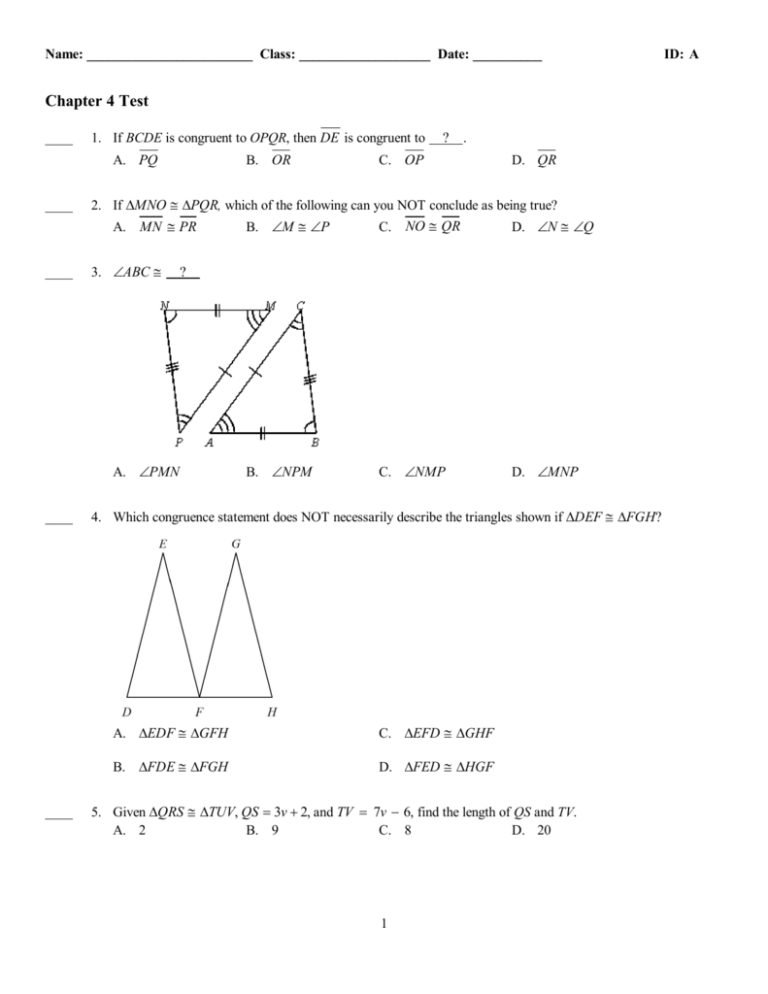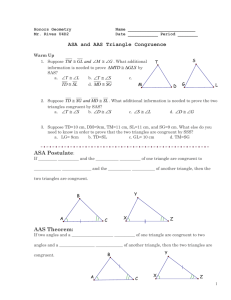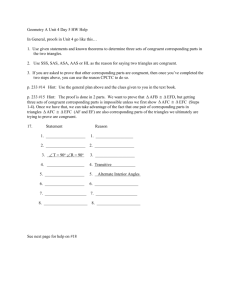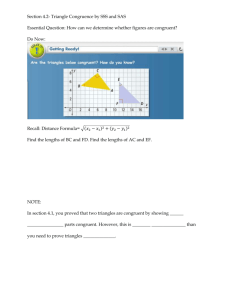Geometry Fall 2012 Review Chapter 4 Test
advertisement

Name: ________________________ Class: ___________________ Date: __________ Chapter 4 Test ____ 1. If BCDE is congruent to OPQR, then DE is congruent to A. PQ ____ B. OR 3. ABC ____ D. QR B. M P C. NO QR D. N Q B. NPM C. NMP D. MNP ? A. PMN ____ C. OP 2. If MNO PQR, which of the following can you NOT conclude as being true? A. MN PR ____ ? . 4. Which congruence statement does NOT necessarily describe the triangles shown if DEF FGH? A. EDF GFH C. EFD GHF B. FDE FGH D. FED HGF 5. Given QRS TUV, QS 3v 2, and TV 7v 6, find the length of QS and TV. A. 2 B. 9 C. 8 D. 20 1 ID: A Name: ________________________ ID: A ____ 6. Given ABC PQR, mB 3v 4, and mQ 8v 6, find mB and mQ. A. 22 B. 11 C. 10 D. 25 ____ 7. In the paper airplane, ABCD EFGH, mB mBCD 90, and mBAD 131. Find mGHE. A. 131 ____ B. 49 C. 90 D. 59 8. The two triangles are congruent as suggested by their appearance. Find the value of c. The diagrams are not to scale. A. 4 B. 5 C. 3 2 D. 38 Name: ________________________ ____ ID: A 9. Use the information given in the diagram. Tell why MN PO and NOM PMO. A. Transitive Property, Reflexive Property B. Given, Given C. Reflexive Property, Transitive Property D. Given, Reflexive Property ____ 10. Justify the last two steps of the proof. Given: RS UT and RT US Prove: RST UTS Proof: 1. RS UT 2. RT US 3. ST TS 4. RST UTS 1. Given 2. Given 3. ? 4. ? A. Symmetric Property of ; SSS C. Reflexive Property of ; SSS B. Reflexive Property of ; SAS D. Symmetric Property of ; SAS 3 Name: ________________________ ID: A ____ 11. Name the angle included by the sides PN and NM . A. N B. P C. M D. none of these ____ 12. What other information do you need in order to prove the triangles congruent using the SAS Congruence Postulate? A. BAC DAC B. AC BD C. CBA CDA D. AC BD 4 Name: ________________________ ID: A ____ 13. Which triangles are congruent by ASA? A. ABC and GFH C. HGF and VTU B. HGF and ABC D. none ____ 14. Which pair of triangles is congruent by ASA? A. B. C. D. 5 Name: ________________________ ID: A ____ 15. What is the missing reason in the two-column proof? Given: MO bisects PMN and OM bisects PON Prove: PMO NMO Statements Reasons 1. MO bisects PMN 2. PMO NMO 3. MO MO 1. Given 2. Definition of angle bisector 3. Reflexive property 4. OM bisects PON 5. POM NOM 6. PMO NMO 4. Given 5. Definition of angle bisector 6. ? A. ASA Postulate C. AAS Theorem B. SSS Postulate D. SAS Postulate ____ 16. Name the theorem or postulate that lets you immediately conclude ABD CBD. A. AAS B. SAS C. ASA 6 D. none of these Name: ________________________ ID: A ____ 17. Can you use the SAS Postulate, the AAS Theorem, or both to prove the triangles congruent? A. either SAS or AAS C. AAS only B. SAS only D. neither ____ 18. What else must you know to prove the triangles congruent by ASA? By SAS? A. ACD CAB; AB CD C. ADC CAB; AD BC B. ACD CAB; AD BC D. ACD CAB; AD AC 7 Name: ________________________ ID: A ____ 19. From the information in the diagram, can you prove FDG FDE? Explain. A. yes, by ASA C. yes, by SAS B. yes, by AAA D. no ____ 20. Supply the reasons missing from the proof shown below. Given: AB AC , BAD CAD Prove: AD bisects BC Statements Reasons 1. AB AC 1. Given 2. BAD CAD 2. Given 3. AD AD 3. Reflexive Property 4. BAD CAD 4. ? 5. BD CD 5. ? 6. AD bisects BC 6. Definition of segment bisector A. ASA; Corresp. parts of are . C. SSS; Reflexive Property B. SAS; Reflexive Property D. SAS; Corresp. parts of are . 8 Name: ________________________ ID: A ____ 21. What is the value of x? A. 71° B. 142° C. 152° D. 76° B. 62° C. 112° D. 124° B. 43.25° C. 133.25° D. 46.75° ____ 22. What is the value of x? A. 68° ____ 23. What is the value of x? A. 86.5° 9 Name: ________________________ ID: A ____ 24. Two sides of an equilateral triangle have lengths x 2 and 2x 20. Which could be the length of the third side: 14 x or 2x 4? A. 2x + 4 only C. 14 – x only B. both 14 – x and 2x + 4 D. neither 14 – x nor 2x + 4 ____ 25. The legs of an isosceles triangle have lengths x 1 and x 7. The base has length 3x 3. What is the length of the base? A. 4 C. 3 B. 6 D. cannot be determined ____ 26. Find the values of x and y. A. x 44, y 46 C. x 90, y 44 B. x 46, y 44 D. x 90, y 46 ____ 27. In an A-frame house, the two congruent sides extend from the ground to form a 34° angle at the peak. What angle does each side form with the ground? A. 156 B. 146 C. 73 D. 78 10 Name: ________________________ ID: A ____ 28. Find the value of x. The diagram is not to scale. A. x 60 B. x 21 C. x 15 D. none of these ____ 29. For which situation could you immediately prove 1 2 using the HL Theorem? A. I only B. II only C. III only 11 D. II and III Name: ________________________ ID: A ____ 30. Is there enough information to conclude that the two triangles are congruent? If so, what is a correct congruence statement? A. Yes; CAB DAC . B. Yes; ACB ACD. C. Yes; ABC ACD. D. No, the triangles cannot be proven congruent. ____ 31. RQ is a perpendicular bisector to PS at Q between P and S. SPR PSR. By which of the five congruence statements, HL, AAS, ASA, SAS, and SSS, can you immediately conclude that PQR SQR? A. HL, AAS, ASA, SAS, and SSS C. HL, AAS, and ASA B. HL and AAS D. HL and ASA ____ 32. What additional information will allow you to prove the triangles congruent by the HL Theorem? A. A E C. AC DC B. mBCE 90 D. AC BD 12 Name: ________________________ ID: A ____ 33. What common side do GDE and HED share? A. ED C. HD B. GD D. GD ____ 34. What common angle do CDG and FCE share? A. C C. E B. F D. D 13 Name: ________________________ ID: A 35. If BCD FED, what are the congruent corresponding parts? 36. Is there enough information to prove the two triangles congruent? If yes, write the congruence statement and name the postulate you would use. If no, write not possible and tell what other information you would need. 37. Name a pair of triangles in the figure and state whether they are congruent by SSS, SAS, ASA, AAS, or HL. Given: NP OM , MN PO 14 ID: A Chapter 4 Test Answer Section 1. 2. 3. 4. 5. 6. 7. 8. 9. 10. 11. 12. 13. 14. 15. 16. 17. 18. 19. 20. 21. 22. 23. 24. 25. 26. 27. 28. 29. 30. 31. 32. 33. 34. D A D B C C B C B C A B B D A A C B A D A A B C B C C B C B B C A A 35. Sides: BC FE , CD ED , DB DF Angles: B F, C E , BDC FDE 36. Yes; PQS RQS by SAS. 37. MNP POM by SSS 1





